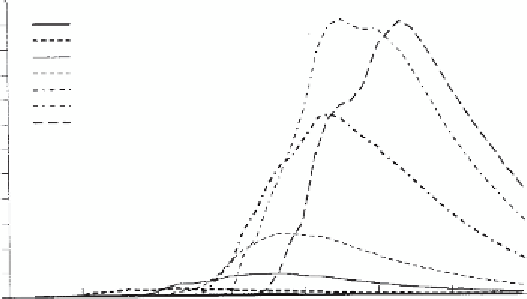Geoscience Reference
In-Depth Information
600
550
500
450
400
350
1 Sep
15 Sep
1 Oct
15 Oct
1 Nov
15 Nov
1 Dec
300
250
200
150
100
50
0
Sep Oct Nov Dec Jan Feb Mar
Figure 5.17
Average concentration of 1,3-dichloropropene in the drain pipes over
the period 1960-1989 after application of 85 kg ha
-1
at various dates for a loamy soil
(Groen,
1997
).
As an example,
Figure 5.17
shows the average 1,3-dichloropropene concen-
trations in the drain pipes over the period 1960-1989 in case of several applica-
tion dates. The highest concentrations are reached when the pesticide is applied
around 15 November. Leaching at earlier applications is less due to less ground-
water recharge and higher temperatures; leaching at later application is less as
the pesticide reaches the groundwater during springtime when soil water perco-
lation decreases and soil temperature rises. Application at 15 October instead of
15 November results on average in about ive times lower concentrations in the
drains. The scenario studies showed some effective measures to decrease pesti-
cide leaching: (1) allow pesticide application only during summertime, (2) adopt
new drainage criteria with increased drain depth and (3) increase ploughing depth
(Groen,
1997
).
Question 5.17:
Why do you think these three methods are effective to reduce pesticide
leaching on clay soils with macropores?
5.11 Summary
Transport of nutrients, pesticides and salts affects directly the environmental qual-
ity of soil- and groundwater. Convection is the main transport process in the vadose
zone. Diffusion and dispersion smooth out solute concentration differences. Adsorp-
tion and decomposition play a key role in the minimization of solute leaching to
groundwater. The general convection-dispersion equation is derived and applied to
various compounds. Analytical solutions for solute pulses and breakthrough curves
are discussed. Salinization of irrigated soils allows the application of steady-state

Search WWH ::

Custom Search